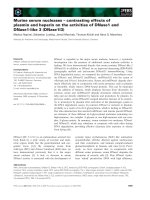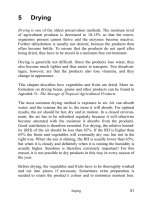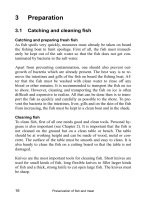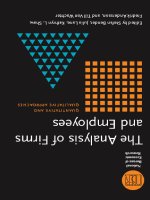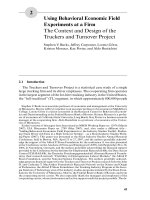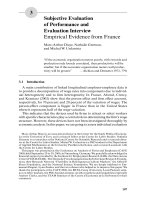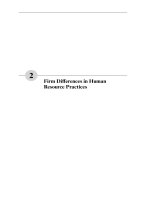The Analysis of Firms and Employees Part 3 doc
Bạn đang xem bản rút gọn của tài liệu. Xem và tải ngay bản đầy đủ của tài liệu tại đây (200.84 KB, 26 trang )
3.1 Introduction
A main contribution of linked longitudinal employer-employee data is
to provide a decomposition of wage rates into components due to individ-
ual heterogeneity and to firm heterogeneity. In France, Abowd, Creecy,
and Kramarz (2002) show that the person effect and firm effect account,
respectively, for 70 percent and 20 percent of the variation of wages. The
person-effect component is bigger in France than in the United States
where it represents half of the wage variation.
This indicates that the devices used by firms to attract or select workers
with specific characteristics play a central role in determining the firm’s wage
structure. However, these devices have not been investigated thoroughly by
economic analysis. In this paper, we are going to assess individual evaluation
107
3
Subjective Evaluation
of Performance and
Evaluation Interview
Empirical Evidence from France
Marc-Arthur Diaye, Nathalie Greenan,
and Michal W. Urdanivia
“If the economic organization meters poorly, with rewards and
production only loosely correlated, then productivity will be
smaller; but if the economic organization meters well produc-
tivity will be greater.” —Alchian and Demsetz (1972, 779)
Marc-Arthur Diaye is an associate professor at the Center for the Study Political Econom-
ics at the University of Evry, and a research fellow at the Center for Labor Studies. Nathalie
Greenan is a researcher at the National Centre for Scientific Research and a research direc-
tor at the Center for Labor Studies. Michal W. Urdanivia is a PhD student in the Department
of Applied Mathematics at the University Panthéon-Sorbonne, and a research assistant with
the Center for Labor Studies.
This paper was presented at the Conference on Analysis of Firms and Employees (CAFE
2006) held September 29 to 30, 2006, in Nuremberg, Germany. We gratefully acknowledge the
financial support provided by the Institute for Employment Research (IAB), the Data Access
Center (FDZ-BA/IAB), The Deutsche Forschungsgemeinschaft (German Research Founda-
tion), their Research Network “Flexibility in Heterogeneous Labour Markets,” the Alfred P.
Sloan Foundation, and the National Science Foundation. We are deeply indebted to Em-
manuel Duguet, Lynn Zucker, and the two referees who helped us to improve this paper. We
thank the participants at the CAFE 2006, the BETA-Cereq (University Louis Pasteur) semi-
nar on labor markets, the PSE-Jourdan seminar on labor markets and inequalities (especially
Andrew Clark), and the TEAM Seminar of the Centre d’Economie de la Sorbonne for their
comments.
interview, a human resource management (HRM) practice that could con-
tribute to the two goals of selecting workers and stimulating their effort. In
France, 52 percent of employees with more than one year of seniority in
manufacturing had been evaluated at least once in 1997. At that time, evalu-
ation interviews were not regulated at the national or at the industry level.
As an HRM practice, the function of evaluation interviews is not clear-
cut. Sometimes viewed as formal performance appraisal systems, evalua-
tion interviews often use complex evaluation grids referring to loosely de-
fined behavioral characteristics as well as to precisely defined goals and
measured criteria.
To assess evaluation interviews, it is useful to analyze them theoretically
and to investigate empirically how they are implemented within firms. The
theoretical framework we are going to use in this paper is the one (hereafter
the DGU model) proposed by Diaye, Greenan, and Urdanivia (2007).
Intuitively, individual evaluation interviews are used to assess perfor-
mance once the employee has undertaken her or his task. We will use here
the term of ex post evaluation interviews. But, if we refer to a classic wage-
setting mechanism, there is no need for evaluation. The incentive wages
drives the employee toward the level of effort that is optimal for the em-
ployer. In the DGU model, ex post evaluation interviews insure risk ad-
verse agent against technological or market uncertainty.
In the French context, Crifo, Diaye, and Greenan (2004) observe that
evaluation interviews are significantly more frequent when the employee is
involved in collective work. The model of ex post evaluation interviews is
limited to give account of the function of evaluation interviews when em-
ployees work in teams because individual performance appraisal become
difficult when the output cannot be separated between the members of a
team (Alchian and Demsetz 1972). Diaye, Greenan, and Urdanivia (2007)
propose a model of ex ante individual evaluation interviews specific to the
teamwork context, where evaluation comes first, before the constitution of
teams and aims at fostering a team spirit. They conclude their theoretical
approach by establishing some predictions about drivers and outcomes of
individual evaluation interviews.
In this paper, we want to assess empirically part of these predictions. Our
empirical investigation rests on a matched employer-employee survey (sec-
tion 3.2) on organizational change and information and communication
technology (ICT) use (computerization and organizational change [COI]).
In the labor force section of the survey, employees are asked whether they
have been interviewed individually at least once in 1997. They also give in-
formation on work organization, on personal characteristics, and on out-
comes. The business section of the survey gives a detailed set of firm-level
characteristics reflecting technological and organizational choices imple-
mented in French manufacturing at the end of the 1990s. We use a propen-
108 Marc-Arthur Diaye, Nathalie Greenan, and Michal W. Urdanivia
sity score methodology (section 3.3) to evaluate (section 3.4) the causal
effect of individual evaluation interviews on effort, work overload, and
wage setting. In section 3.5, we conclude.
3.2 The Data
We are going to use a matched employer-employee survey, the survey on
computerization and organizational change (COI), to assess the DGU
model of evaluation interviews. The information we have in the survey will
not allow us to test all the predictions from their model. However, from the
employee section of the survey, we have some information on the charac-
teristics of work (whether individual or collective), on evaluation inter-
views, on effort, and on wages. This will allow us to cover the main features
underlined by the DGU model. More precisely, we will be able to test
whether evaluation interviews lead to higher levels of effort than classical
incentive schemes (prediction 1). Our estimation strategy will also allow us
to assess the existence of a selection effect associated with the implementa-
tion of evaluation interviews in individual and collective work organiza-
tions (prediction 2). Furthermore, using measures of work overload, we
will check whether evaluation interviews drive workers toward an excessive
work intensity leading to inefficiencies (prediction 3). Indeed, according to
the DGU model, evaluation interviews in a context of supermodular tech-
nology (i.e., the conditional probability of success of the task is a strictly
increasing convex function of the employees’ level of effort) lead to an
overintensification of work in the sense that the employees’ level of effort
will be higher than the one “required” by the firm. The reason is the selec-
tion effect regarding disutility of effort. Prediction 3 is a possible conse-
quence of this result on overintensification. It is important to test this
implication because work overload is a major factor of stress and has long-
term implications on the health of the workforce, especially in a context of
aging. Finally, we will be able to test our predictions on wage differentials
and on the employees’ knowledge of the rules driving wage setting between
the scheme with evaluation interviews and the classical incentive scheme
(prediction 4).
The COI survey was conducted at the end of 1997 by the French public
statistical system.
1
We are going to work on a representative sample of
Subjective Evaluation of a Performance and Evaluation Review 109
1. The conception and coordination of the COI survey has been directed by the Center for
Labor Studies. The survey has been carried out in a consortium involving the Ministry of
Labor (DARES), the Ministry of Industry (SESSI), the Ministry of Agriculture (SCEES),
and the National Institute of Statistics and Economic Studies (INSEE). It benefited from
very high response rates: 82 percent for employers and 75 percent for the employees. For a
detailed description of the survey, see Greenan and Hamon-Cholet (2001) or http://www
.enquetecoi.net.
manufacturing firms with more than fifty employees and on a sample of
randomly selected employees within these firms. In matched employer-
employee surveys, the budget constraint implies a trade-off between trying
to capture the diversity of firms and trying to capture the diversity of the
workforce within firms. By choosing to interview small sample of employ-
ees (one, two, or three) within each firm, COI chooses to favor the diversity
of firms. As interviewed employees have at least one year of seniority
within the firm, they belong to its core workforce.
In the full sample of the labor force section of the survey, there are 4,295
employees. However, in our analysis, we do not take into account employ-
ees with supervision activities (1,214 individuals) or employees working
part time (177 individuals). Indeed, the former combine a position of Prin-
cipal and of Agent that we have not investigated theoretically, while part
time leads to badly measured effort and wages. We obtain a subsample of
2,904 employees.
The available information on the practice of individual evaluation inter-
views stems from the following question: Do you have at least one evalua-
tion interview per year (yes / no)? Because of their seniority in the firm, we
know that all interviewed employees had the opportunity of being evalu-
ated at least once.
The labor force section of the COI survey describes in detail work or-
ganization. It includes a whole set of questions capturing whether work is
structured around group activities. From these questions, we build up five
different measures of interaction between employees in the course of the
work process: being part of a team, time spent in teamwork, intensity of
communication with other workers, level of support from other workers,
participation in meetings (see appendix A for detailed questions). These
five measure are positively correlated, with correlations ranging between
0.04 (intensity of communication with time spent in team work) and 0.18
(being part of a team and level of support from other workers). Thus, they
measure different dimensions of collective work. We derive from these five
measures a synthetic binary indicator of collective work. When it takes the
value 1, the employee is considered as being a “collective” worker, when it
takes the value 0, he or she is considered as being an individual worker. Ac-
cording to this variable, our sample of employees breaks down into 1,537
individual workers and 1,367 collective workers.
Table 3.1 gives the distribution of individual evaluation interviews ac-
cording to our synthetic binary indicator of collective work. In 1997, 37.2%
of the employees have been interviewed at least once. Evaluation inter-
views are positively correlated with collective work: 47 percent of collective
workers have been evaluated against 29 percent of individual employees.
The COI survey also measures different effort indicators. Productive
effort is measured through two questions indicating if the employee works
110 Marc-Arthur Diaye, Nathalie Greenan, and Michal W. Urdanivia
longer than the usual hours some days or some weeks. Productive effort is
considered as very high if the employee sometimes increases hours worked
for personal reasons, as high if he or she sometimes increases hours
worked in response to the firm’s demand, and as low if longer hours never
happen. According to these three situations, the productive effort indica-
tor, respectively, takes a value of 2, 1, or 0. The cognitive effort indicator
is a binary variable indicating if the employee makes propositions to im-
prove his or her workstations, the production process, or the machines. It
measures an involvement in collective knowledge building about the pro-
ductive activity, allowing continuous improvement of the production pro-
cess.
Two additional measures are included in the analysis to identify if effort
is going beyond reasonable levels, creating an overload that could be detri-
mental for work efficiency and for the employee’s health. A first variable
indicates how often an employee has to hurry in the course of his or her
work. Four states are taken into account: hurrying almost all the time,
hurrying for one quarter of the time or more, hurrying for less than a quar-
ter of the time, and never. The hurry variable, respectively, takes the value
4, 3, 2, and 1 according to the intensity of the pressure. Work overload is
also measured through a binary indicator telling whether the employee of-
ten has to interrupt one task to carry out another urgent and nonantici-
pated one.
Finally, we measure the employee’s annualized net wage in euros. As it
comes from an administrative data file used to compute social contribu-
tions, it is precisely measured and includes all bonuses, taxed allowances,
and compensations in kind. We also build up an indicator of the employees’
ability to predict their wages. It rests on a question about the elements that
have a big influence on the employee’s wage or promotion, followed by a
list of eight items. We compute the ratio of the number of yes responses
to the list of items, on the number of yes and no, which gives an indicator
taking its value between 0 and 1. Zero means that the employee has no idea
of how to increase his or her wage or chance of promotion, 1 means that
the employee knows that he or she can improve his or her situation and is
aware of what to do to obtain this outcome.
Subjective Evaluation of a Performance and Evaluation Review 111
Table 3.1 Evaluation among individual workers and collective workers
Evaluation Individual workers Collective workers
Yes 445 (29%) 637 (47%)
No 1,092 (71%)
a
730 (53%)
Total 1,537 (53%) 1,367 (47%)
a
Percentage with respect to the analyzed subsample of 2,904 employees.
3.3 Estimation Strategy
We want to measure the impact of evaluation interviews on effort, work
overload, and wages, but we know from the DGU model that evaluation
interviews induce a selection process. Employees with a low disutility of
effort and, in the case on teamwork, with a team spirit are going to be at-
tracted by jobs where evaluation interviews are conducted periodically. A
possible way to measure outcomes related to evaluation interviews, taking
into account the selection effect, is to consider evaluation interviews as
treatments and to apply a propensity score method to match each treated
individual with a nontreated individual with the same characteristics in or-
der to turn our nonexperimental data into a quasi experiment.
A simple way to test the predictions of the DGU model is to consider
evaluation interviews as treatments and to evaluate the effect of this treat-
ment on the chosen variables for measuring effort, wages, and beliefs about
wages. More precisely, let t be a dummy variable equal to 1 if the employee
declares being evaluated and 0 otherwise. Three quantities are of interest
to us. The first is the average treatment effect over the whole population,
written C; the second is the average treatment effect over the treated indi-
viduals, written C
1
; and the third is the average treatment effect over the
nontreated individuals, written C
0
. More precisely, let Y be the chosen vari-
ables for measuring effort, wages, and beliefs about wages. Then C mea-
sures the variation of Y that would be observed if the whole population was
treated; C
1
is an evaluation of the effect of the treatment in the usual sense
because it concerns the treated population; and C
0
is a prospective evalua-
tion in the sense that it measures what would happen if the nontreated pop-
ulation was treated. We have:
C ϭ E(Y
1
– Y
0
)
C
1
ϭ E(Y
1
– Y
0
| t ϭ 1)
C
0
ϭ E(Y
1
– Y
0
| t ϭ 0),
where Y
1
is the observed value of Y that results when receiving treatment
(that is, when being evaluated), Y
0
is the observed value of Y that results
when not receiving treatment (that is, when not being evaluated), and E(.)
denotes expectation in the population. Intuitively, an estimate of an aver-
age treatment effect could be the difference between the average of Y over
the population of treated individuals and its average over the population of
nontreated individuals, that is,
Y
ෆ
1
– Y
ෆ
0
,
where Y
ෆ
1
and Y
ෆ
0
are, respectively, the average of Y for treated (evaluated
employees) and the nontreated (nonevaluated employees).
112 Marc-Arthur Diaye, Nathalie Greenan, and Michal W. Urdanivia
However, broadly speaking, the main problem when evaluating the
effect of a treatment is that for each individual we only observe
Y ϭ t ϫ Y
1
ϩ (1 – t) ϫ Y
0
ϭ
Ά
.
Then it can be shown that the average difference between treated and non-
treated individuals can be the cause of a selection bias because the data
does not result from a randomized experiment. And when testing evalua-
tion effects (on effort, overload, and wages), there is a need to control for
naturally occurring systematic differences in background characteristics
between the treated population and the nontreated population, which
would not occur in the context of a randomized experiment. Moreover,
according to prediction 2, individual evaluation interviews affect employ-
ees’ efforts through a selection effect associated to disutility or to team
spirit, an incentive effect that in our case is estimated by the average treat-
ment (evaluation) effect. Therefore, in order to estimate the average treat-
ment (evaluation) effect, it is also necessary to control for the selection bias
due to disutility. Although it seems difficult to control “directly” for this se-
lection effect because disutility or team spirit are not observable charac-
teristics, we can assume that they are grounded on observable background
characteristics of the employee and of the employer, and, hence, control-
ling for them allows to control for the selection.
We will discuss in the next section the background characteristics we will
take into account to estimate the effect of individual evaluation interviews.
We choose to use the propensity score methodology introduced by Rosen-
baum and Rubin (1983). This method reduces the entire collection of back-
ground characteristics to a single composite characteristic that appropri-
ately summarizes the collection. Propensity score technology allows to
correct the selection bias by matching individuals according to their pro-
pensity score, which is the estimated probability of receiving the treat-
ment (of being evaluated) given background characteristics. We are going
to use a nonparametric kernel matching estimator proposed by Heckman,
Ichimura, and Todd (1997, 1998), which under some regularity assump-
tions is convergent and asymptotically normal.
3.4 The Results
3.4.1 Determinants of Individual Evaluation Interviews
The first step of the propensity score method is to analyze the determi-
nants of evaluation interviews, taking into account background character-
istics that influence the employee’s probability of receiving a periodical
Y
1
if t ϭ 1
Y
0
if t ϭ 0
Subjective Evaluation of a Performance and Evaluation Review 113
evaluation interview and the three categories of outcomes we consider:
effort, work overload, and wages.
In this step, it is very important to take into account individual effects as
well as contextual effects. As we have pointed out, personal characteristics
of the employee like team spirit or disutility of effort are going to play a
crucial role in influencing both the chances of being evaluated and the out-
comes we consider. These characteristics are not directly observable, but
we are going to take into account observables that are possibly correlated
with them: gender, age, seniority, education level, and occupation. It is
clear that these personal characteristics have impacts on effort levels, work
overload, and wages.
The fact that our employee sample is matched with a survey describing
the characteristics of firms is an important advantage in our estimation
strategy. The DGU model has stressed that the production technology plays
a role in the diffusion of evaluation interviews. A supermodular technology
is more favorable than a submodular technology. In order to control for the
technology, we are going to include the regression size and sector dummies.
Stemming from an employer database, information on size and sector is
much more precise than the information usually included in labor force sur-
veys. We also include a measure of the firm’s computerization intensity. We
choose to build up a variable describing the intensity of numerical data
transfers within and outside the firm. Moreover, evaluation interviews
could be complementary to other organizational practices, and these prac-
tices could also have an influence on outcomes. Eight new organizational
practices are considered in the logistic regression: quality certification, to-
tal quality management, methods to analyze products and processes (value
analysis; functional analysis; Failure Mode, Effects, and Criticality Anal-
ysis [FMECA]), total productive maintenance (TPM), organization in
profit center, formal in-house customer/supplier contracts, system of just-
in-time delivery, and system of just-in-time production. We also detail
different teamwork practices: self-managed teams, problem solving groups,
and project teams. Finally, we take into account the evolution of the num-
ber of hierarchical layers in the firm and variables indicating difficulties con-
nected with the implementation of organizational changes.
Appendix C presents the parameters estimated of the logistic models ex-
plaining individual evaluation interviews for individual workers and for
collective workers. In the case of individual workers, we find that employee
characteristics have higher explanatory power than employer characteris-
tics. More precisely, male workers in executive or middle management po-
sitions with either low seniority (one or two years) or intermediate senior-
ity (seven to ten years) have a higher probability of being evaluated. We
have to keep in mind that even though some of the interviewed workers
have management positions, they have no formal hierarchical authority
as they declare no subordinates. Among the employer characteristics, the
114 Marc-Arthur Diaye, Nathalie Greenan, and Michal W. Urdanivia
only variables with significant influence are size, with a positive impact of
the highest size cluster; sector, with a positive impact of five sectors (phar-
maceutical, perfumes, and cleaning products; chemicals, rubber, and plas-
tic products; electrical and electronic equipment; electrical and electronic
components; and shipbuilding, aircraft, and railway); and quality certifi-
cation (ISO 9001, ISO 9002, and EAQF).
In contrast, in the case of collective workers, employer characteristics
tend to explain more than employee characteristics. Indeed, for team
workers the only personal characteristic that influences the probability of
being evaluated is the level of education: a second or third level of educa-
tion is associated with a coefficient that is positive and significant. On the
employer side, size, sector, computer intensity, use of new organizational
devices, and use of teamwork have a significant impact on the probability
of being evaluated. Employers with medium size (between 100 and 999 em-
ployees) and belonging to pharmaceutical, perfumes, and cleaning prod-
ucts or to chemicals, rubber, and plastic products use evaluation interviews
more frequently. Employers from printing, press, and publishing and ship-
building, aircraft, and railways have a lower probability of being inter-
viewed. The intensity of computerization favors evaluation interviews of
collective workers as well as quality certification and total productive
maintenance. Conversely, employers using just-in-time delivery are less
oriented toward evaluation interviews for collective workers. Having a
nonmarginal fraction of production workers in problem solving groups fa-
vors evaluation interviews, while having a small fraction of nonproduction
workers participating in self-managed teams and having management in-
volved in project teams has a negative impact on evaluation interviews. In
total, evaluation interviews for collective workers seem complementary
with information technologies and new organizational practices. These
managerial tools could support a supermodular production technology,
where the employer has a preference for higher levels of effort.
3.4.2 Observing the Outcomes of Individual Evaluation
We are now going to discuss the matching evaluation of the effect of
individual evaluation interviews on individual and collective workers on
effort (table 3.2), work overload (table 3.3), and wages (table 3.4). In each
table, we first compute as a benchmark the average outcome for individual
and collective workers. Second, we compute the average difference in out-
come between workers that have been individually evaluated and workers
that have not been evaluated. This estimator is often designated as the
naive estimator of the treatment effect. Then we compute the three causal
effects: the effect on the treated (C1), the effect on the nontreated (C0), and
the global effect (C). The first effect is the matching evaluation strictly
speaking, the second one represents the effect that evaluation interviews
would have if they were implemented on the nonevaluated population of
Subjective Evaluation of a Performance and Evaluation Review 115


